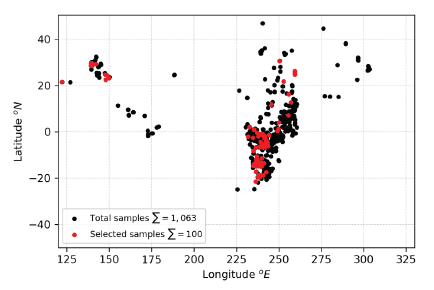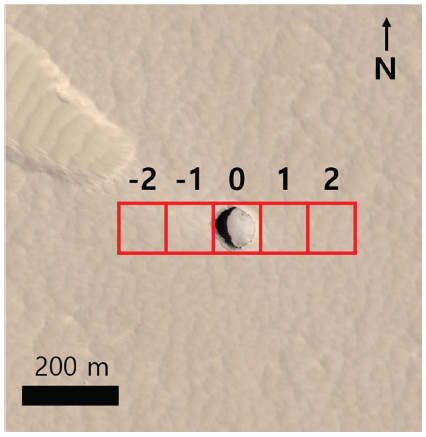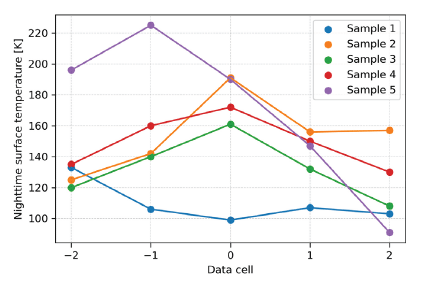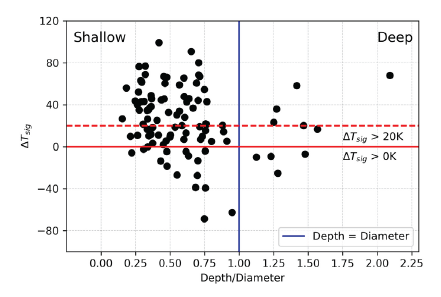1. INTRODUCTION
The lack of a planetary atmosphere and magnetosphere of Mars allows bombardments of micrometeorites and energetic cosmic particles on the planetary surface, making the environment hostile to life that we know. This harsh environment not only threatens human exploration of Mars but also can destroy molecules that may preserve evidence that hints at the habitability of ancient Mars. Therefore, pinpointing a safe location that can protect life/biomolecules is being highlighted in the context of exploration and scientific purposes.
One of the possible candidates that can provide a safe environment for human exploration to Mars is caves. Since the first detection of cave entrance candidates that were found by the obtained optical images, more than 1,000 candidates were added manually by close examinations of the satellite images (Cushing et al. 2007;Cushing 2012). The physical characteristics of Martian cave candidates, including shapes, depths, and diameters, are all available in the Mars Global Cave Candidate Catalog (MGC3) (Cushing 2015). The origin of these cave entrance candidates is currently considered to be the lava-tube pit craters formed by the collapse of lava tubes (Cushing et al. 2007).
A previous study investigated the surface temperature profile of seven cave candidates that are listed in the MGC3 (Jung et al. 2014). The study found that during the nighttime, some of the cave candidates exhibited a higher surface temperature than that of the surrounding areas. However, since the paper investigated less than 1% of the listed cave candidates, an extended investigation of the temperature profile is required to provide general cave candidate temperature tendencies. Furthermore, the extent of the difference between the cave candidate and the surrounding area has not been explored in detail. These investigations may provide additional information that can be used with the current pit crater detection that uses a topologically induced brightness profile (Jung et al. 2016). Also, as similar cave entrance candidates have been reported on Moon, the investigations may be applied to the search for the Moon cave entrance candidates (Hong et al. 2014).
In this paper, we extend the temperature profile of Martian cave candidates up to 100 cave entrance candidates. As the temperature values of cave candidates during daytime are more significantly disturbed by the shadow than the nighttime cave candidate temperatures, we select nighttime temperature values to investigate the temperature properties of cave entrance candidates.
2. DATA AND METHOD
For the temperature profile, we select a total of 100 cave entrance candidates that have values of depth and diameter from the MGC3. Since the temperature analysis applied in this paper involves the extraction of the satellite thermal image pixel value of the corresponding cave entrance candidate and the values of its surrounding areas, the extraction limit of cave entrance candidates without diameter can not be constrained. Therefore, we exclude 963 cave entrance candidates without diameter and depth values from the MGC3 dataset in this paper. The locations of these samples relative to the total cave candidates are presented in Fig. 1.

The nighttime surface temperature data was obtained from Thermal Emission Imaging System (THEMIS) onboard the Mars Odyssey orbiter (Christensen et al. 2004). The data was gathered through Java Mission-planning and Analysis for Remote Sensing (JMARS) software (Christensen et al. 2009). We designed a set of 5 bins aligned with the longitude that extracts the temperature values of corresponding positions. The center bin of the extraction bin-set was set to be centered at the targeted cave entrance candidate using the longitude and latitude values from MGC3, see Figs. 2 and 3.


The extracted temperature values were then calculated by:
where Ti indicates the extracted nighttime temperature values of the corresponding extraction bins (cave candidate is set to i = 0) and ΔTsig indicates the extent of the temperature difference between the cave entrance candidate and its surrounding areas.
3. RESULTS
Among 100 cave entrance candidates, 79 samples showed positive temperature difference values, which was predicted by Jung et al. (2014). Over 74% of the 79 positive temperature-signature samples (59/79) showed a temperature difference larger than 20K. We examined the relationship between the temperature difference and depth-to-diameter ratio to investigate how the shape of cave candidates affects the temperature signature (see, Fig. 4). The samples with depth-to-diameter ratios less than one indicate “shallow” cave morphology, while those larger than one indicate “deep” cave morphology. No significant differences between shallow and deep cave entrance candidates were found. This may be due to the lack of deep cave entrance cave samples (10% of the analyzed samples).

4. SUMMARY AND DISCUSSION
To extend the temperature profile of the cave candidates and investigate the extent of temperature differences between the cave entrance candidate and their surrounding areas, we explored the nighttime surface temperature of 100 cave candidates. 79% of the cave candidates showed a higher surface temperature than the surrounding areas regardless of their morphology (deep or shallow), implicating that the temperature may serve as a parameter in detecting the cave entrance candidates.
We also tested whether the morphology of the cave entrance candidate affected the temperature difference. The distribution of temperature differences ( ΔTsig ) did not show a significant difference between deep or shallow cave entrance candidates, suggesting the morphologies of cave entrance candidates may not have a notable effect on the nighttime temperature difference tendency. However, since the number of deep cave entrance candidate samples is nine times smaller than that of shallow samples, a follow-up investigation of detecting high depth-to-diameter ratio cave entrance candidates may contribute to the improvement of our analysis.
A recent study reported the development of a deeplearning program that detects the cave entrance candidate automatically (Nodjoumi et al. 2021). The deep learning model learns the patterns of the satellite image of cave entrance candidates and applies the patterns to the new surface regions to detect new cave entrance candidates. Since providing additional information on the target (here, cave entrance candidates) to the deep learning model can improve its accuracy, the nighttime temperature difference pattern explored in this study may contribute to the future cave entrance candidate detecting programs that use deep learning models.
In addition, Bardabelias et al. (2020) attempted cave detection using radar observation of the Martian subsurface. Incorporating additional geophysical datasets, such as gravimetry and seismic wave measurement around cave entrance candidates, may provide detailed physical characteristics of the Martian caves, improving our understanding of these sites. A combination of these datasets will contribute to the improvement of our current remote sensing limits of cave detection on Mars.









